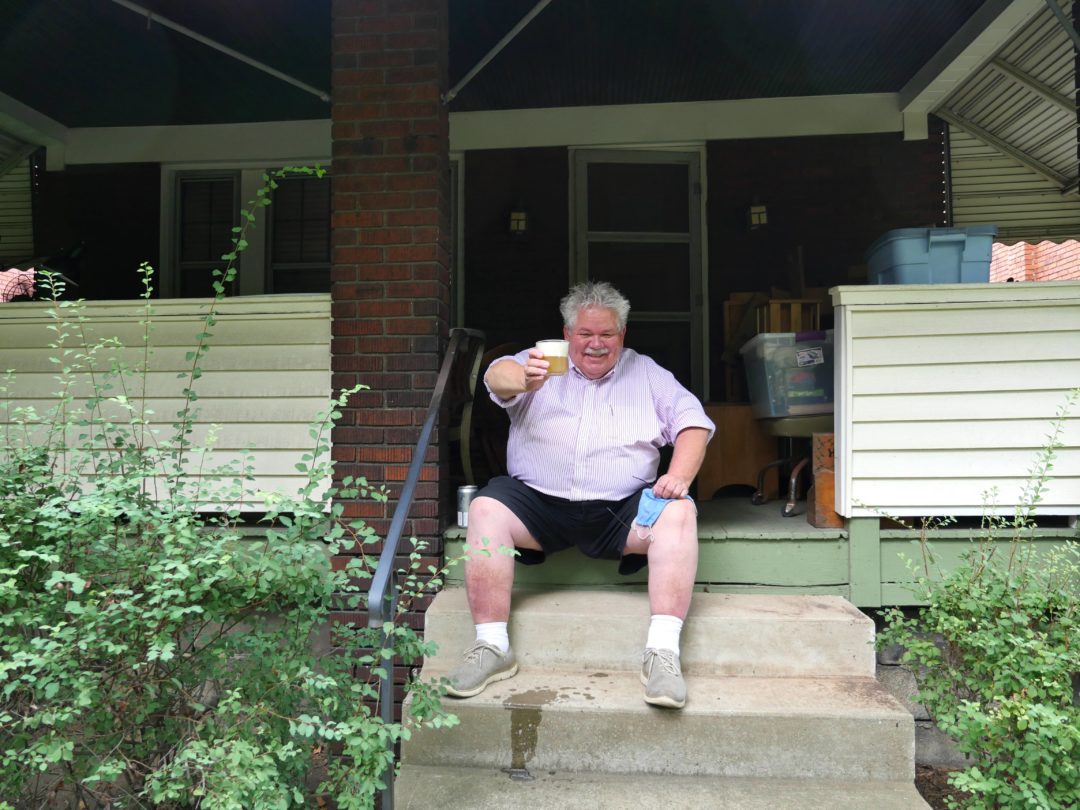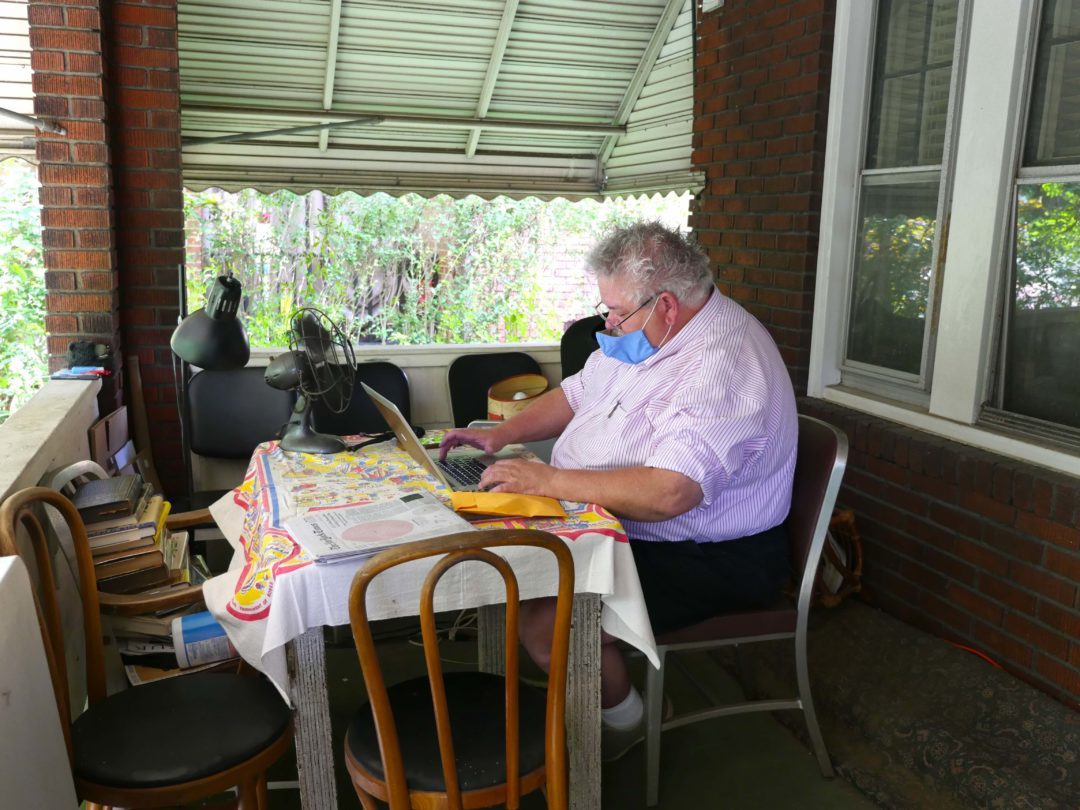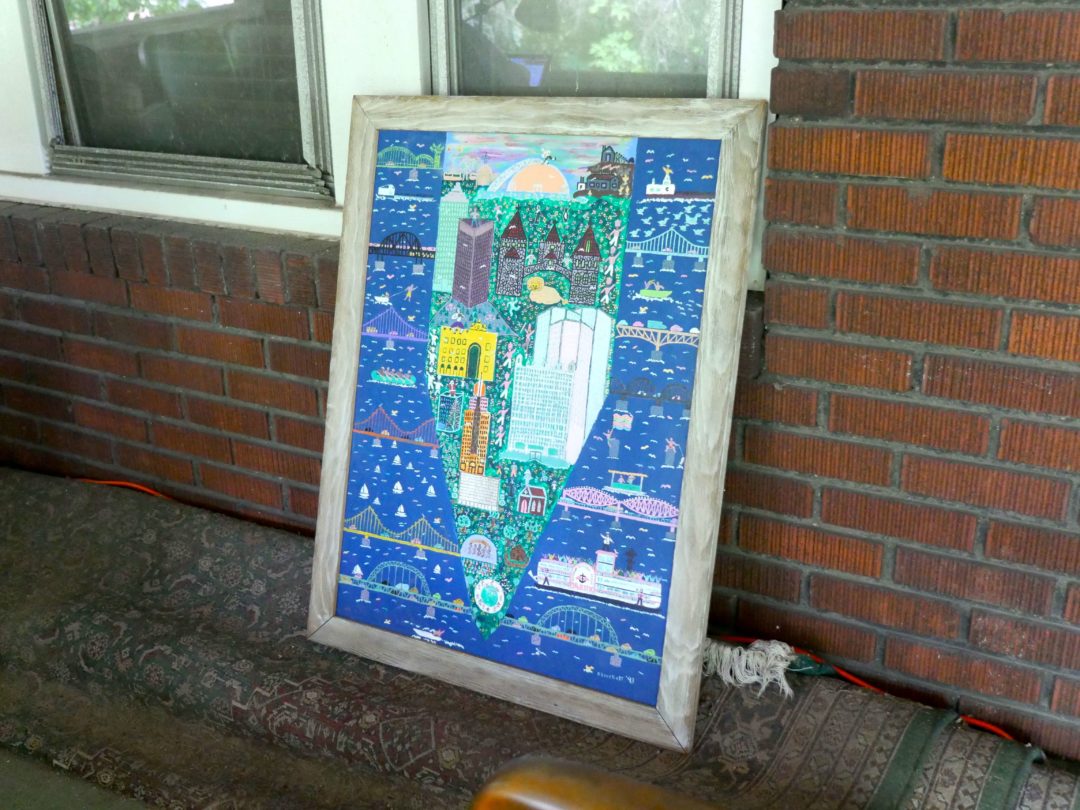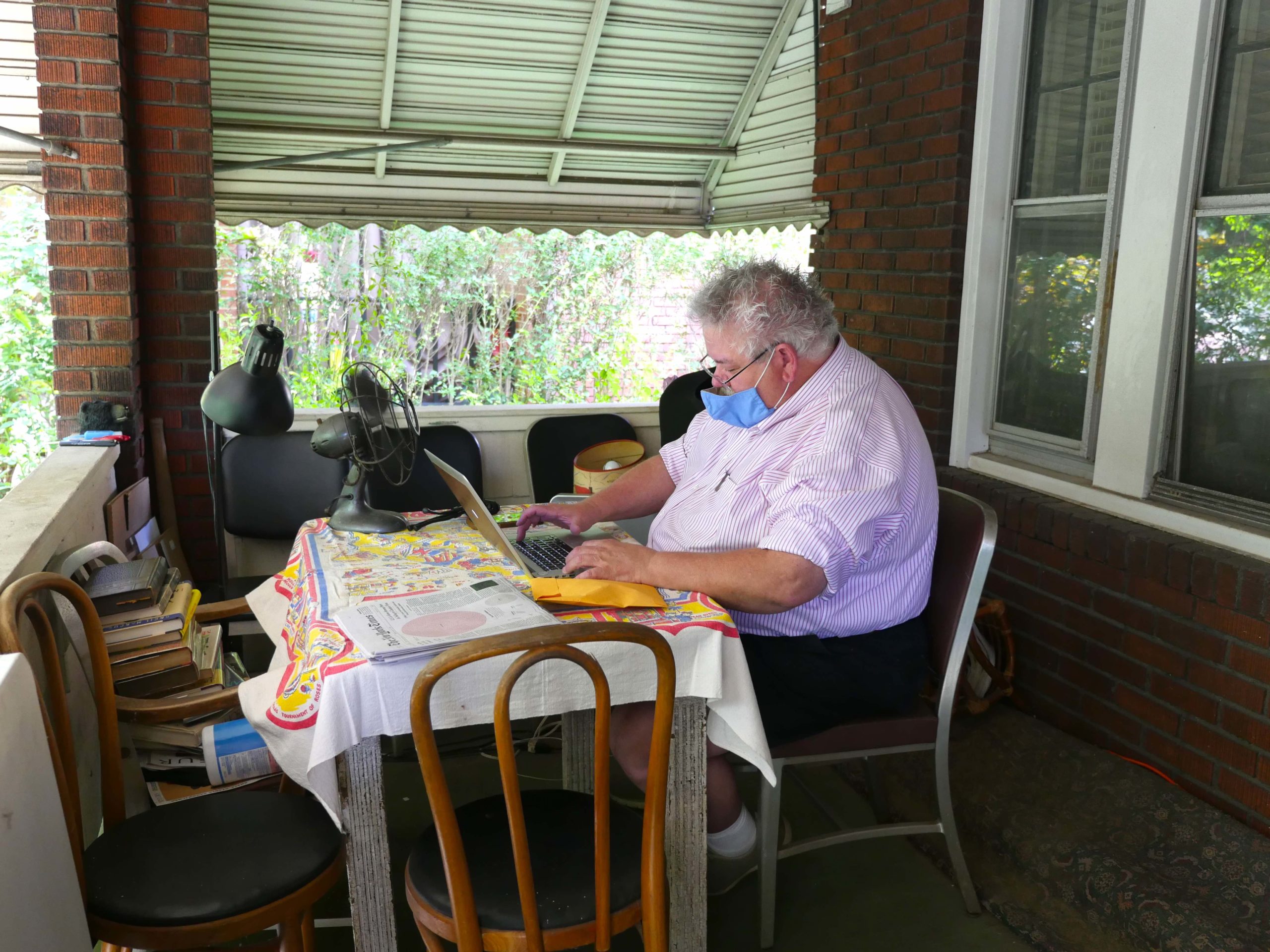This story is part of our Back to School series. To see more stories like this, check out our History curriculum. Follow Very Local on Facebook & Instagram for updates.
If you follow Rick Sebak online, you’ll know that he’s been keeping busy during the pandemic. Despite working from home, he’s still been posting videos chronicling his front porch adventures, cookie deliveries to Chris Fennimore’s house and even a road trip to get some artisanal hot dogs from Heritage Craft Butchers in Marianna, PA. Nothing’s going to stop Rick from telling stories, doing research and sharing his love of Pittsburgh. Even when Rick was stuck in bed a few years back, recovering from a ruptured quadriceps tendon, he still managed to make a show about his recovery titled “My Seven Weeks at Magee.” I caught up with Rick on the phone to ask him about his love of Pittsburgh history, his approach to research and, well, how Rick Sebak became Rick Sebak.

Were you interested in Pittsburgh history as a kid?
I can’t say I was a great history student. I was more interested in English class than social studies or civics. But I think anyone who grows up here has a certain amount of Pittsburgh pride. And I remember one summer, the summer after my first grade year, I got to go to the Falk School. It was for gifted and talented kids, or something like that, and my mom made a deal with them that she would drive me to Oakland from Bethel Park every day, if they would take my older brother too. She said, “I’ll drive Rick if you take Skip too.” And so they agreed to that. And she literally made every day this great adventure. We would either go to the Carnegie Library or the museum or we would have a picnic in Schenley Park. We would do something really cool. Or we’d go to Hazelwood to see the things that she used to do when she was a little girl. That was a really incredible summer and those things all played a role in my initial love of Pittsburgh, which was then renewed when I moved back in ‘87.
Today, it seems that everyone is a Pittsburgh boomerang, living somewhere else for a few years then coming back. Some of my colleagues at Very Local were speculating that maybe you’re the original boomerang?
Even at the time that I did that, they called it the boomerang. I wouldn’t call myself the first boomerang, though I think I was an unusual boomerang, in that I was not looking for it. I’d been working in South Carolina at ETV for 11 years, and there were two guys I worked with. We had all been there for a while and we had made a pact that if anyone got his 10-year pin at the station, the others would kill him. And I was the only one who got a 10-year pin. I saw a picture recently where I almost have an ashamed look in my eyes as I’m being handed my 10-year pin. But one of those guys called me and told me that he’d seen an ad in Broadcast Magazine and that the station in Pittsburgh was looking for a local producer. I always thought I’d go somewhere else like New York or D.C., but my friend said that you never see a big station like WQED searching for a producer. So I answered their ad and that’s how I got this job. That’s what brought me back to Pittsburgh. I did all those things that people tell you to do. I made lists of pros and cons. My parents were still here, which was a plus and a minus.
And do you remember what it was like, coming back to Pittsburgh after more than a decade away?
Having been away from ‘71 to ‘87, I came back with some fresh eyes. That’s when I came to the realization that there’s a lot to like here. And what an interesting history we have. As the 19th century became the 20th century, we were a world capital. All this industry was happening here and oil was discovered north of Pittsburgh. I just loved all that stuff. You know, it’s really weird that thirty-three years later, I still feel that excitement. I remember when I did my Downtown Pittsburgh show we went to the Arrott Building at 4th and Smithfield. We liked it because it looks like it has stripes. And it’s a first generation skyscraper, which means that it’s between 10 to 14 stories tall because that’s how far an elevator could take you at the time. I looked into the history of Arrott – the guy who built it – and he was the guy who figured out that you could put enamel on iron and make a bathtub. He did it here in Pittsburgh and he called his company Standard Manufacturing and it still exists as American Standard. You’ll see it on toilets and urinals. He was the bathtub millionaire. I still get this thrill out of learning this stuff. Because Pittsburgh’s this interesting place where unexpected things happen, like bathtubs.
Was it hard to make the transition back to Pittsburgh in ‘87?
I was very busy with work, which was a blessing because I think I was lonely. I didn’t have that support group of friends when I moved back. Even though I had grown up here, most of the people I went to high school with had moved away. A lot happened in that first year. Mayor Caligiuri died and I had to do a lot of research on the history of Pittsburgh mayors because I was asked to do some commentary during a live broadcast of his funeral. Nancy Polinsky and I were the hosts. And I think I was asked because I was Catholic and I knew the Mass that was going on in St. Paul’s Cathedral.
And you made so many programs for WQED, right from the start.
When I look back on it, those first two or three years were extremely productive. In fact, someone just asked me how long it took to edit Kennywood Memories. We shot until the end of August and it was on in October, so we whipped it together. We shot and edited so fast. And it was also done linearly – we didn’t have computer editing – so we couldn’t move things around very easily. If you ran out of time you had to go back and literally cut something out. Even before I did Kennywood, I had done three or four shows. I did my long interview with Fred Rogers and I did a show called The Mon, The Al & The O, about the three rivers. And that’s all in that first year.
So in a way, all those first films pushed you into the deep end of the pool, in terms of Pittsburgh history.
I remember at the time that if you had told me to drive to Kennywood, I could. But if you had laid a map out in front of me and asked me to find Kennywood, I would have had no idea. I knew you could see the river and the steel mill. I didn’t know any of that stuff.
In the early days, were you assigned the topics for your shows?
Yeah, that’s exactly right. The Mon, The Al and The O was a project that someone else had started. They called it “Three Rivers” and I was given a stack of research. Nothing had been shot so it was entirely my program by the time it came about. Flying Off the Bridge to Nowhere was an assignment because the school of engineering at CMU had come to WQED and said that they would like a show about the bridges. I think it’s Flaubert who said, “everything is interesting if you look at it long enough.” And I think that’s true. Although bridges might not be my first choice, when you start to learn about them, everything becomes interesting and fascinating.

Where do you go to do your research?
I learned to use the library as much as you can, and now you can use the internet to make it even easier to find all sorts of sources. I never make it a secret because if you tell people what you’re working on, they’ll generally have some suggestions for you. “Oh, do you know about this?” And I generally don’t. It’s funny because we did An Ice Cream Show before the internet became a factor and it was just word of mouth. Every place we went, we would ask the ice cream people, “well, if you can’t eat at your own ice cream place, where would you want to go?” I even asked that of Ben & Jerry and they said, “well, if we’re on the west coast we would want to go to Robin Rose in Venice, California.” So I did a story on Robin Rose in Venice, California. By the time we did the hot dog show, there was the internet and search engines so we could use that for research. I love the research part of it. I love finding out new things and being surprised. Being surprised is the best thing in life.
Are there places you go locally to do research?
In Pittsburgh, there are three places I always check. The Pennsylvania Department at the Carnegie Library in Oakland – they’re up on the third floor and it’s an incredible resource. I also like to check in with the archives at Pitt. Miriam Meislik is our contact there and we always like to check in with Miriam. And then at the Heinz History Center. Those are the three places you want to go no matter what you’re doing about Pittsburgh history. But at the same time there are historical societies in every neighborhood. And they’re wonderful and have unexpected treasures. I remember spending a day or two at the Dormont Historical Society. They do a big neighborhood celebration every year in the summer. I did a Pittsburgh Magazine article about that.
And that’s another thing that you’re always researching for – the Pittsburgh Magazine articles?
Fifteen years ago, I got invited to do an article every month, and that’s a different kind of history than I cover in my shows. That has allowed me to learn a lot. It’s a different kind of research too. Often, I’ll just hear something from someone. Recently, my friend, Minette, at work came to me and said, “my brother has a story.” Ten years ago his friend hosted this group of up-and-coming European leaders here in Pittsburgh, one of whom was Emmanuel Macron. And so that became a story.

Has there ever been a historical discovery that’s shocked you?
Yes. When we were doing A History of Pittsburgh in 17 Objects, I was checking in with the Fort Pitt Museum to find an object that would tell us about the early history of Pittsburgh. In the process of doing that something else came up and they told me about this incident where the Europeans gave the Native Americans blankets that were infected with smallpox. It was a really early form of germ warfare. I already knew about that but I hadn’t heard that the only known incidence of that, which is codified with paperwork, is at Fort Pitt. It’s pretty damning. It was a British fort back then and there is paperwork from the commander that says that they’re giving these infected blankets to the Native Americans. There’s proof that these guys did it. It’s an unpleasant part of Pittsburgh history. And there are a lot of parts of Pittsburgh’s story that aren’t nice but that’s part of our history too.
Has the research that you’re doing from one project ever led you to another project?
I don’t think so. But one time PBS asked me if there was something that I’ve always wanted to do a show about. So I said, “Pittsburgh cemeteries.” You know, Andy Warhol’s in Bethel Park. Errol Garner, who wrote the song “Misty is Homewood Cemetery.” Andrew Carnegie’s parents are buried in Allegheny Cemetery in Lawrenceville. There’s lots of people over there. I think I did a Pittsburgh Magazine article about Calbraith Perry Rodgers. He’s related to Admiral Perry who fought in Lake Erie and Calbraith is a descendant of his. Calbraith was the first man to fly across America, from coast to coast, and he was a Pittsburgher. He was deaf. He’s 6’4” or something like that and he bought his airplanes from the Wright Brothers. William Randolph Hearst had offered a reward to the first person who could fly across America, so Calbraith organized it and even got a sponsor – a kind of grape pop called Vinn Fizz. There were no airports, so he thought the best thing to do would be to follow the railroad track. Hearst wanted you to do it in 30 days or less so Calbraith put his family in the railroad car along with enough pieces to rebuild the airplane six times. But by the 30th day, he was only in St. Louis. The American public insisted that Hearst extend the contest and he did and then Calbraith did the rest of the country in the next month. When he lands in Pasadena to end the trip there’s like 100,000 people waiting there to meet him. He stays out west and he starts doing little tourist flights over the ocean. Then companies started to ask him to test their parts and on one of the test flights over the ocean, a seagull flew into the plane and he crash landed and died in the water. But he’s buried in Lawrenceville and he has a very nice tombstone with his biplane on it.
Do you have a list of topics for shows that you’d like to do?
No. But earlier this year, before the pandemic, we put together a big proposal and sent it to PBS. I’ve often said, if I could only do one thing for the rest of my life, it would be shows about highways. Because everything’s on a highway. I really enjoyed doing the Lincoln Highway show. So I put together a proposal called “Numbered Highways.” It wouldn’t be Route 66 or the Lincoln Highway because I think they’ve had their share of attention but there are a million others.







